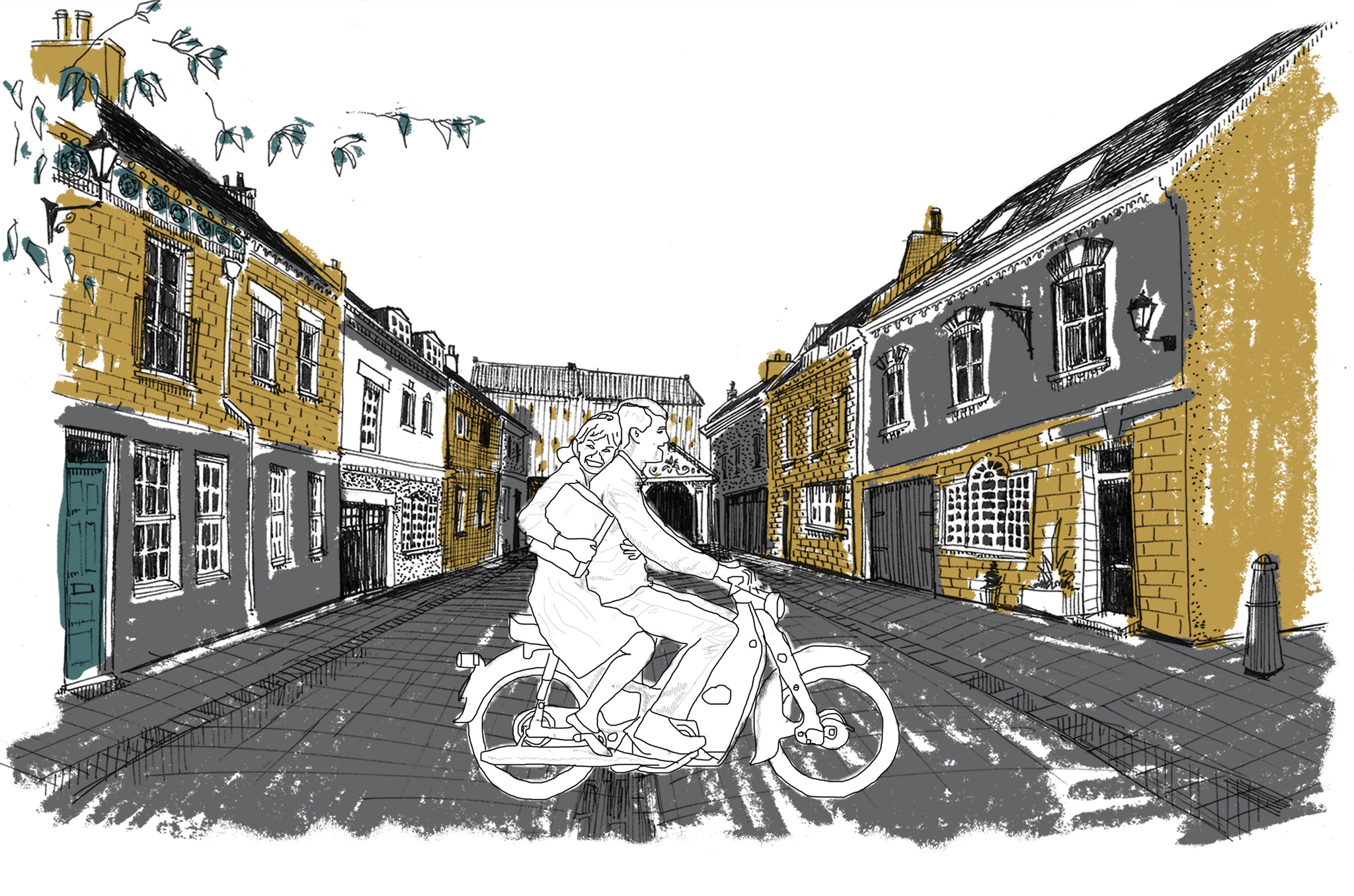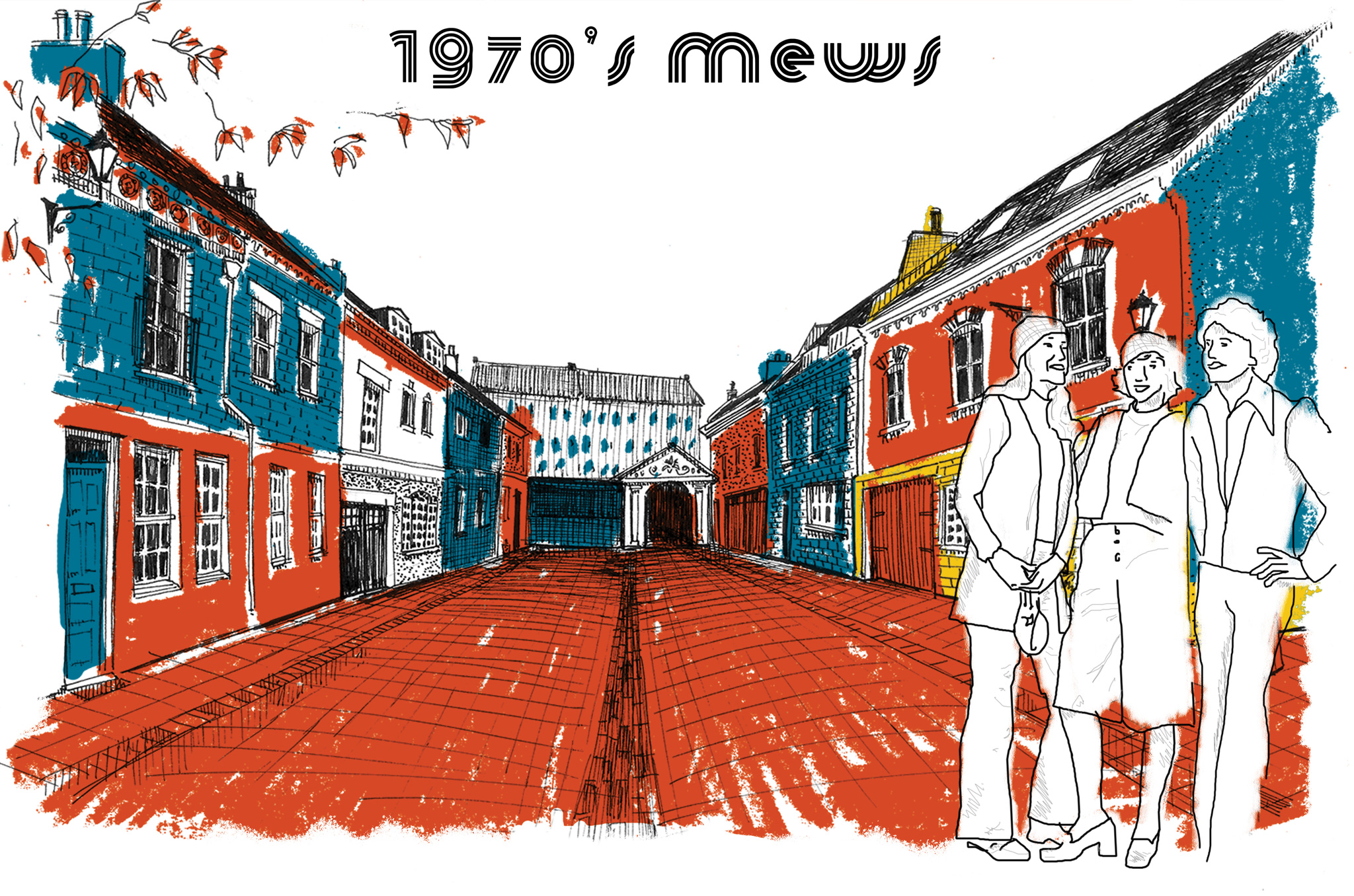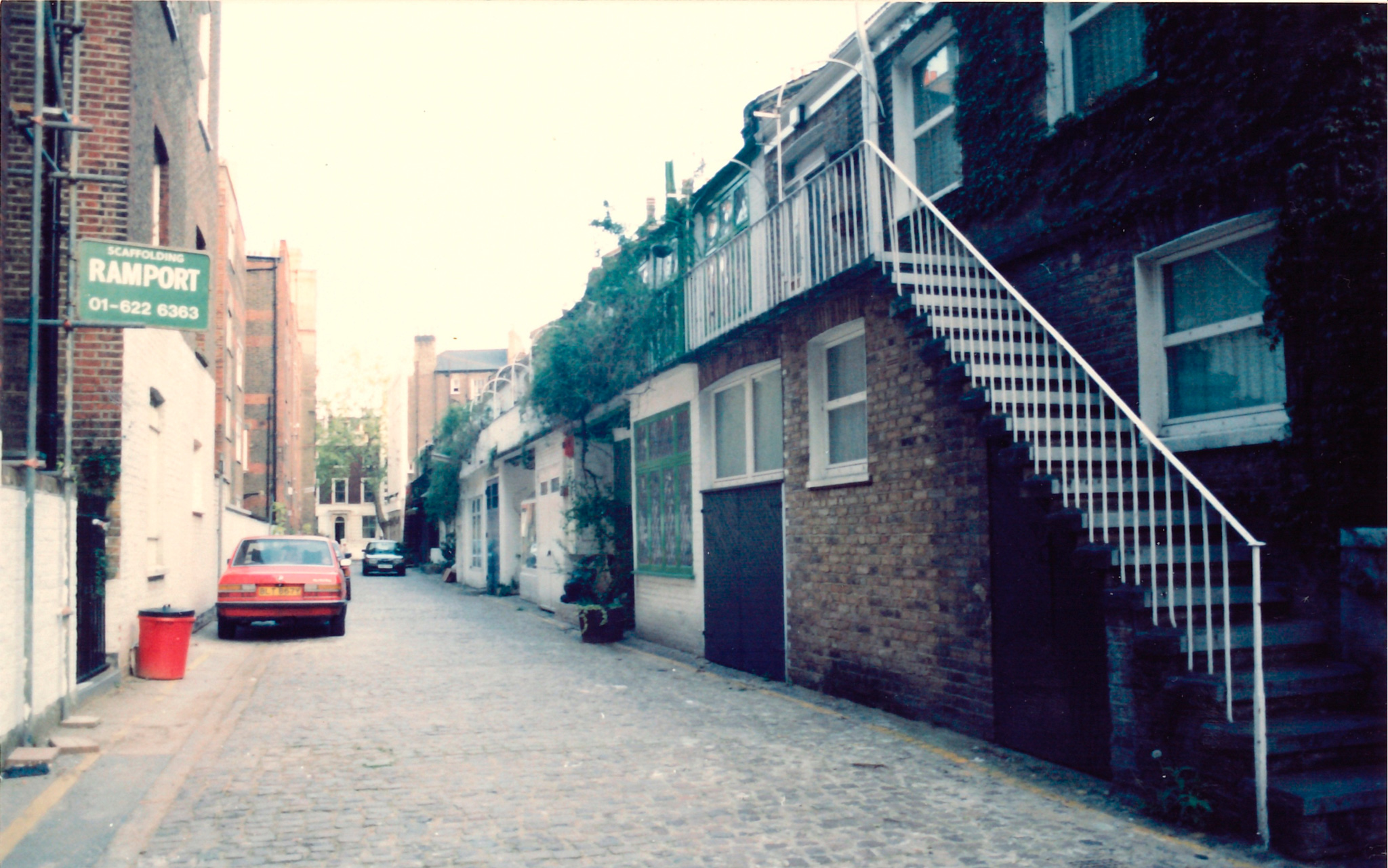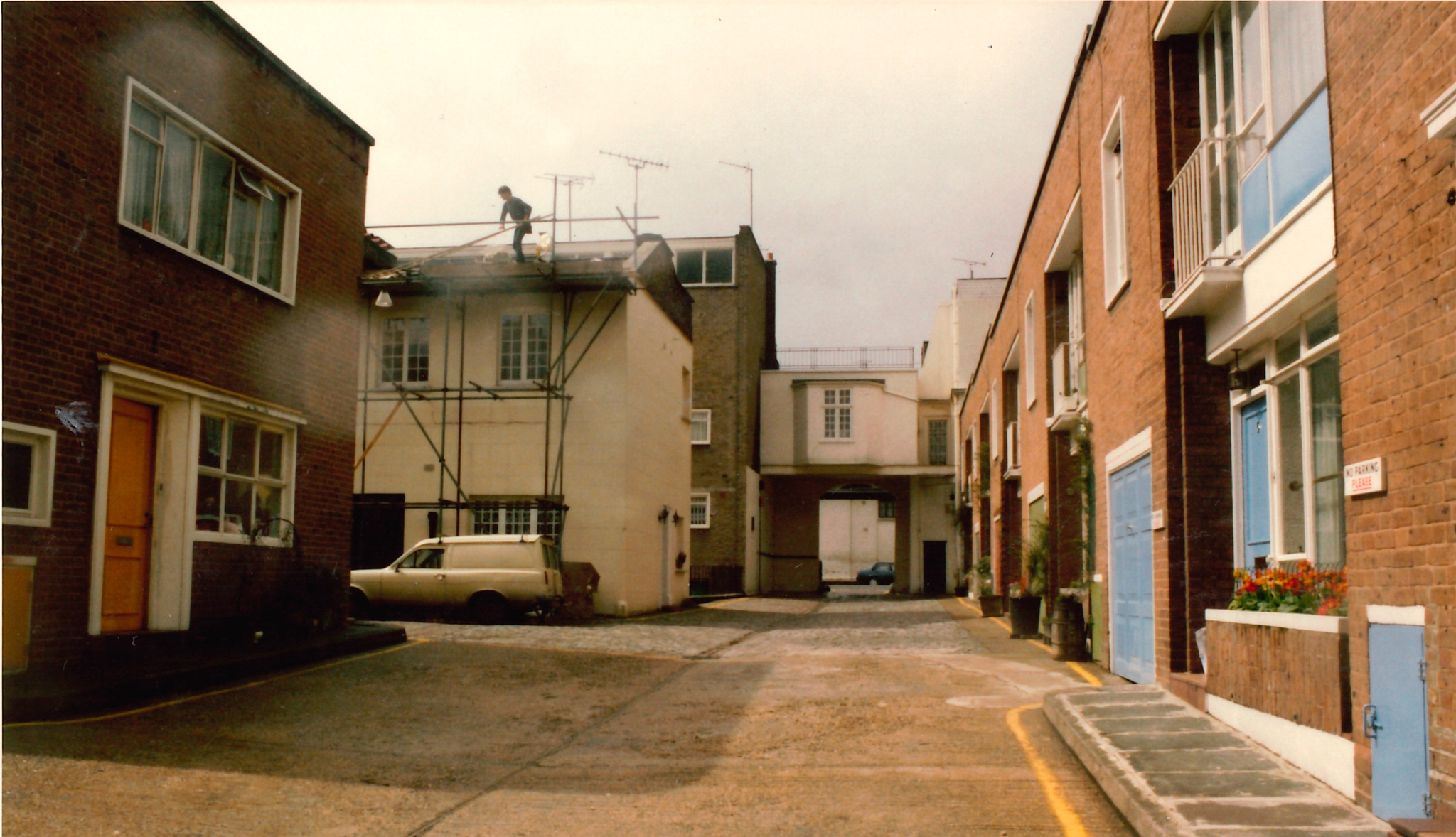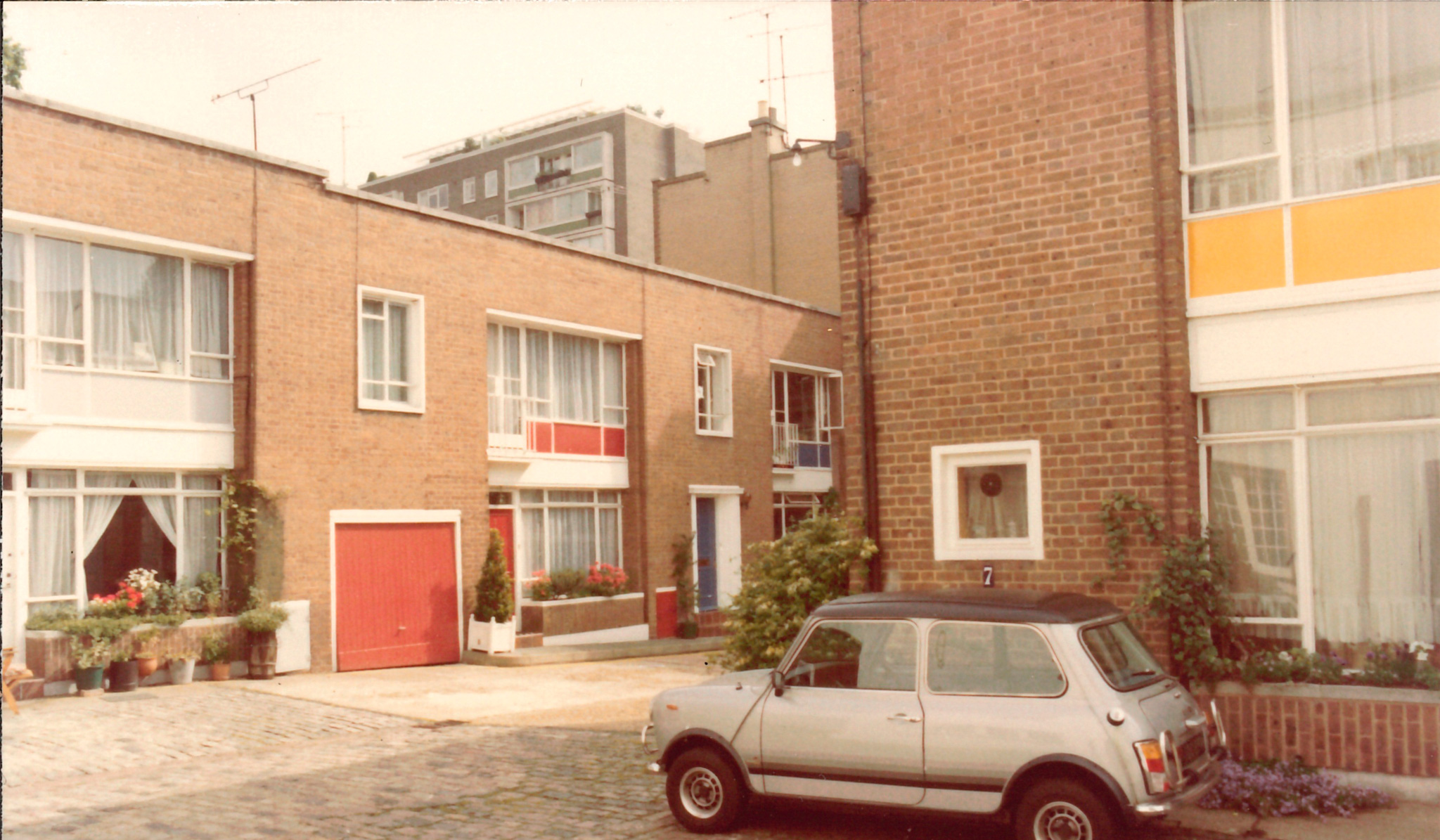The Last 50 Years

These are the second and third of a series of five articles published in 2021 relating to the Everchanging Mews over the last 50 years. It looks at how the events of this period have affected the Mews.
All of ECM’s 2021 posts have been written in collaboration with LUROT BRAND. 2021 marks half a century of their trading as estate agents; we at ECM congratulate them on their success and look forward to their continuing years of achievement.
THE LAST 50 YEARS OF THE EVERCHANGING MEWS – AN INTRODUCTION
By Martyn John Brown
From grungy to far out
The Mews have always been a great focus for fashion, films, photography and are associated with many significant events. Even before the 1970’s they were in the news, with glimpses of Mews in the Avengers (John Steed lived at the fictitious 3 Stable Mews), in newsreels about the ‘Profumo Affair’, and in films like Genevieve and What’s New Pussycat. The Beatles’ film A Hard Day’s Night, and Michael Caine’s The Italian Job, both featured Mews.
This series of articles looks at some of the occurrences and trends that have taken place over the last 50 years, and provides some of the background that has shaped the Mews over this period.
The UK population was around 53 million at the start of the 1960’s and the population of London was around 8.1 million, although this was on a downward trend that continued for the next two decades.
By the 1970’s Mews occupation had developed beyond mere accommodation for staff and animals. It had moved from commercial and mixed usage to become primarily residential, featuring enclaves that were much desired especially by bohemians and the artistic.
Underlying this movement was a sea-change in property ownership that occurred at the end of the 1960’s, following a remarkably sustained period of housebuilding. It resulted in the number of owner occupiers exceeding the number of renters.
The published statistics of nationwide house prices over the last 50 or so years show a clear and consistent upward trend from around 1970, albeit with a few twists and turns along the way.
UK House Price Index showing changes in the value of residential properties
Over the last fifty years house prices generally in the UK have increased dramatically, and have risen even more in London. The price increases for Mews, however, have been even more extraordinary. Generally house price inflation increased by 160%, but in London the price inflation rose by 500% plus, with the result that properties there are now more than double those in the rest of the country. Because they had started slightly lower, London Mews prices rose more.
These increases often surprise people who associate Conservative governments (and Tony Blair’s three Labour terms) with low inflation. House price increases, however, are not included in consumer price increases so inflation rates can be misleading. The increase in house prices reflects a global trend where the rate of return on capital is greater than economic growth. Rising property prices mean that property investment is an attractive way for people to make money, although ultimately it will not match the returns provided by technology investments such as IBM in the 80’s, Microsoft in the 90’s, Apple in the 00’s or Amazon in the 2010’s.
You meet the nicest people in the Mews
THE MEWS MARKET
Mews are variously ‘compact, bijou and perfectly proportioned’; or to put it differently, they are desirable for many reasons. Discussions about the Mews are frequently accompanied by the comment that they represent only a small world within the larger world that is the London property market, so it is not surprising to see trends in Mews sales follow those of the general market. However, whilst the overall trends are similar, the limited number of Mews available keeps prices high and make them an especially good investment over time.
Property is unlike other investments as the motivations of buyers and sellers differ. Whereas the cost of a new food item may be based primarily on supply and demand, the value of a new house is based on a number of salient factors such as need, location, confidence, future value, demographics and interest rates as well as the availability of land, plot sizes, new building numbers, and land tenure.
The flat red line on the above graph before 1970, shows that property prices had not moved until then, as the market was previously fundamentally different in nature. Wages were lower and more people rented, mainly through private landlords.
At the end of the First World War, Britain was a nation where around 80% of the population rented their homes; boom and bust cycles in house prices were yet to come. Between 1950 and the early 1980s home ownership steadily increased, and the renting sector fell. Mrs Thatcher encouraged this trend in the 1980s, with a policy of selling off council homes, primarily to their tenants. The stock of social housing has consequently fallen since the early 1980s.
Since the 1960’s property prices have risen steadily. However, after the millennium there was a particularly dramatic spike, with properties more than doubling in price in the aftermath of 2007’s recession.
The ‘swinging sixties’ were more complicated than their sobriquet alluded to, and included many major events and changes. It was the decade of revolution, the civil rights movement, the counterculture, political changes, and changes in music and society. The decade was to bring us: the Vietnam War, Civil Rights protests, the assassinations of both John F. Kennedy and Martin Luther King and the Cuban Missile Crisis, but it ended on a more uplifting note with the first landing of a man on the Moon.
The 1960’s started with huge potential due to the ebullience of spirit arising to replace the disruption of two world wars. The early 1960’s bought us baby boomers (strong work ethic, self-assured, resourceful and disciplined people) and the late 1960’s brought the changing demographic of Generation X (independent, informal, technologically adept, flexible and educated). The decade presented many possibilities, some of which were in nascent form only, which became fully recognised many years later.
MEANWHILE IN THE MEWS
In the 1960’s the Mews were very mixed and compromised. Wearing their outer clothing loosely, these simple, often flimsy structures were still recognisable for their equine proportions below with modest human accommodation above.
Understanding Mews house prices over the period is by no means an exact science and takes a specialist knowledge earned the hard way. We are fortunate to have a specialist estate agency that can supply
this information, gathered with analysis of their own sales over time.
Lurot Brand commenced trading in 1971 and expanded their operations through the 1970’s, onto Thatcher’s 1980’s and the Blair years, through boom years, a financial crisis, austerity times, then Brexit and, more recently, shutdown Britain. Their operation has come from humble beginnings to be a recognisable brand on the high streets of central London.
LUROT BRAND…
remembers Mews properties since the 1960’s
At the end of the 1960’s there was a strong sense that people wanted to reclaim the Mews and the rest of central London to live in – after years of being encouraged to commute into London from the outer reaches. The effect of the various transport improvements over the previous 50 years or so was to separate living and working areas. This was not to everyone’s advantage and began to be reversed.
The Mews had definitely declined since the previous century when, in effect, they became redundant. As much as there were gains of hope and trends afoot for their reinvention, they were also mired by their underworld association with undesirables. For every inspirational bohemian enclave there was an equal and opposite use by the oppressed and downtrodden.
Leasehold reform was also a big factor, since the Act of 1967. In Belgravia the infamous ‘Prince of Wales Clause’ was created which meant that the leasehold was extinguished if the Prince of Wales died. A new market in sales of Mews opened up and Lurot Brand was born.
“When I first rode into the Mews on my Honda ‘monkeybike’ in the 1970’s, I was excited at the prospect of selling a Mews property but I had no comprehension that they would become a way of life for me nor that I would still be involved in Mews sales some 50 years later. I didn’t or couldn’t have anticipated the huge changes that became possible for the Mews.
Likewise, I had no inkling that Honda would go on to enjoy their success and become the largest motorcycle company in the world.
The last fifty years have brought dramatic changes, worth reflecting on to benefit us going forward.”
Dove Mews, SW5 sold for £16,750 in 1974, costing £15.15 per square foot.
The same Dove Mews sold for £1,975,000 most recently in 2016, costing £1,787 per square foot.
Groovy
THE EVERCHANGING MEWS IN THE 1970’S & 1980’S
THE 1970’S
The 1970’s is a less easy period to label than the ‘swinging sixties’. Referred to as the ‘me decade’ by author Tom Wolfe, because people became more egocentric to escape from wars and protect themselves.
This was an incredibly varied decade. Domestic and foreign strife, included 1974 and 1979, regarded as two of the worst years on record. The 1970’s brought us shocking events and shades of colour, serial killers and killer albums, incredible sporting moments, great books, films and exciting new television shows. Chillingly, the spectre of war remained with both Vietnam and the Cold War reflecting diametrically opposed east and west philosophies.
The UK population was around 56 million and London’s population around 7.5 million. Politically, these were the Heath years between 1970 and 1974, when Edward Heath led a Conservative government. Harold Wilson returned as a Labour prime minister until 1976, when he was replaced by James Callaghan, also Labour, for two more years, until Thatcherism arrived in 1979. This brought about significant changes for the country, including giving people the right to buy their council houses.
The 1970’s were marked by massive worldwide monetary inflation exacerbated by an oil crisis in the Middle East. The price of oil increased drastically in the west, when Arab members of the Organisation of Petroleum Exporting Countries (OPEC), announced that they would no longer export petroleum to nations that had supported Israel in its conflict with Syria and Egypt. This, coupled with rationing, meant that economies went into recession due to massive inflationary pressures.
The advance of science created new digital technology used in consumer products to improve the range and function of home appliances. It was in this period, that the first electronic calculator was introduced.
Across the world it was doom and gloom. The decade began with the split of The Beatles and this coincided with the United States invading Cambodia. The US and its Watergate scandal was rarely out of the news, until Richard Nixon resigned and the Vietnam War ended. New US Presidents came and went with Gerald Ford and then Jimmy Carter.
The decade brought cultural change and technological innovation, such as glam rock and Saturday night fever.
Some of the main events that marked out the 1970’s were:
1970
- Edward Heath became Conservative Prime Minister
- The US invaded Cambodia, widening the war in Vietnam
- The Beatles broke up
1971
- Lurot Brand is born
- India defeated Pakistan resulting in the birth of Bangladesh
- The Bretton Woods’ foreign exchange system, designed to bring world economic stability, was dissolved and currencies were no longer linked to gold – the IMF and World Bank remained
1972
- Watergate scandal started
- Richard Nixon was elected President for a second term
- Bloody Friday: 9 people died and 100 were injured in Belfast
- UK miner strike (also occurred in 1974)
1973
- UK Stock market crash caused recession 1973-75
- The Mariner 10 space probe was launched by NASA becoming the first spacecraft to study Mercury
- UK joined The European Union
1974
- Richard Nixon resigned after the Watergate scandal
- Former VP Gerard Fordbecame 38th US President
- Edward Heath’s Conservative government was defeated by Harold Wilson’s Labour minority government and he became Prime Minister for a second time
1975
- Vietnam War ended after the fall of Saigon
- Jaws became the first blockbuster film
1976
- James Callaghan became Labour Prime Minister
- Jimmy Carter defeated the Republican incumbent Gerald Ford to be 39th US President
1977
- The Panama Canal was returned to Panama from the USA
- There was a dip in house prices
1978
- First test tube baby Louise Brown was born
- Space Invaders the video game was released
1979
- After 15 years in exile, Ayatollah Khamenei returned to power in Iran
- Sony Walkman was introduced
- Margaret Thatcher was elected Conservative Prime Minister dominating politics for the next 11 years
Poor economically, the 1970’s saw high inflation, high unemployment and strikes. In the housing market, 1970 saw house prices rocket but, despite general unrest, a boom in owner occupation marked the start of the mortgage market.
MEANWHILE IN THE MEWS
If the Mews had not proven to be so adaptable over time, if they had not been so well located, if the demand for them had not taken off, then the Mews would not be what are today.
The 70’s was when the Mews came into their own as residential enclaves. Market forces in this period gave them a greater sense of their self-worth, which was clearly reflected in their market standing. When the Conservatives eased credit conditions house price inflation rose peaking at 36% and only ending with the OPEC oil embargo in the mid 1970’s.
Prior to this, interest in Mews had not succeeded in making them coveted homes. Most were awaiting modernisation, many still having space for horses with large draughty stables and coach houses below with cramped flats above. As a more cool culture arrived in the 70’s, Mews suddenly became places in which to ‘shake your bell bottoms whilst listening to disco music’.
People eyed up Mews for their growth potential. A typical Mews, at around 1200sq ft., compared favourably to a two-bedroom flat with the added attraction of a parking space. All that you needed to develop one – apart from the money – was foresight and imagination. An evolution was afoot, but still a long way from multiple en-suites, multimedia rooms, or wi-fi.
Mews properties were mostly located in Conservation areas, designated under the 1967 Civic Amenities Act. Although common for many listed buildings under the Listed Building process 1947, to be located within designated Conservation areas, in London fewer than 6% of Mews properties are listed, but around 90% are in designated Conservation areas. In fact, two Boroughs – Westminster and The Royal Borough of Kensington and Chelsea – contain about 80% of existing Mews (Westminster having about 50% and RBKC about 30%). Within Westminster there are 20 Wards and all but three of these contain Mews. The highest number are in Knightsbridge and Belgravia, followed by Marylebone, the West End and Hyde Park wards.
Across hereditary London Estates, land tenure changes were afoot, where many of the mews had been developed. Over time, Parliamentary Acts were introduced changing the benefits that had historically benefited the aristocracy and landowners.
The first Leasehold Reform Act was dated 1967 and allowed leaseholders to extend their leases, subject to qualifying criteria, to a new standard of 90 years. Then, through subsequent changes to legislation, it became possible to obtain the freehold of the property. All of which meant that the ground landlord’s role was diminishing and had to be redefined to deal with the management of the areas previously owned.
In 1973, housing boom and bust arrived with what became known as the ‘Barber Boom’. The Conservative chancellor, Tony Barber pushed growth, which resulted in house price inflation peaking at 36%; average house prices doubled in three years. As Britain’s finances plummeted, little significant or large scale building development in London occurred.
LUROT BRAND…
remembers Mews properties in 1970’s
The 1970’s were a good time to sell Mews properties. At the end of the 1970’s there was a sense of change coming…
We began selling Mews in 1971 and sold a steady number of properties before there was a defined market and demand accelerated the supply. Initially, the limitation on tenure affected the supply for the first 20 or so years. Now it is possible to buy freeholds, or at the very least a virtual lease with a very long leasehold interest. However, back then you were more likely to have to contend with a short lease or even two separate leasehold interests, left after the hereditary estates had dispensed with the properties. Whilst such uncertainties can still exist, nowadays the purchaser can buy with the advantage of knowing the various Leasehold Reform Acts will provide more certainty of tenure, when they come to extend their lease or enfranchise.
At the beginning of the 1970’s a Mews in Bayswater would sell for around £16,700 (equating to £15/SQFT) whereas by the end
of the decade it would sell for £60,000 (equating to £54/SQFT).
Dove Mews in 1974 sold for £16,750.
Dove Mews in 1979, 5 years later, sold for £60,000.
Simply Bodacious
THE 1980’S
The 1980’s is referred to by many as the ‘greed’ decade. The conservative politics of Margaret Thatcher and Ronald Reagan held sway until the 1990’s. The 80’s brought us Michael Jackson, Gordon Gecko, ‘Yuppies’, MTV, the Falklands War, Glasnost and Perestroika from the USSR, Aids, drug culture, the first space shuttle (Columbia), the fall of the Berlin Wall and big shoulder pads.
Microsoft, IBM, Intel and Apple began to have a significant impact on our lives as small computers became cheaper and more widespread, increasing their use in homes and businesses. Mobile phones began to be used more generally as technology became cheaper and the products smaller. Famine in Ethiopia caused Bob Geldof to bring major music stars together to raise money and awareness.
When the 1980’s dawned, the UK population remained at around 56 million and the London population at around 6.7 million. Politically, a Conservative Government dominated, led by Margaret Thatcher, who remained in power from 1979 until 1990. In 1980, she offered the aspiring working class the right to buy their council houses by introducing the Housing Act 1980 – effectively transferring state capital wealth to the people.
In 1986, the Greater London Council (GLC) was abolished under Margaret Thatcher. The GLC’s powers were then devolved to the London Boroughs and other entities.
Towards the end of the 1980’s the boom in office building reached a hiatus. Under Nigel Lawson, the UK’s second housing boom occurred causing house prices to rise 16% in 1987 and 25% in 1988. The early 1980’s bought us the ‘millennials’ (team players, educated, self-confident, family centric, and achievement-oriented people). Unfortunately, following a long period of growth and low unemployment, by the end of the decade the economy began to slow and unemployment rose.
Towards the end of the 1980’s, the commercial property market collapsed and as we entered the 1990s, little public or private development was undertaken.
This was a decade marked by great pop culture, outlandish fashion and ‘big’ hair. People listened to new wave, punk and funk music as well as rap, introducing other trends from America such as break dancing. People would take to the Mews in their Air Jordans, listening to their Sony Walkmans whilst trying to solve the Rubik’s cube.
Some of the main events that marked out the 1980’s were:
1980
- John Lennon shot dead
- Ronald Reagan elected 40th President of the United States
- The US boycotted the 1980 Moscow Olympics
1981
- Lady Diana Spencer and Charles, Prince of Wales were married
- The housing market dipped
1982
- Margaret Thatcher was re-elected following British victory in the Falklands War with Argentina
1983
- Microsoft released ‘Word’, their word processing program
1984
- Band-Aid recorded ‘Do they know it’s Christmas?’, the charity single for famine relief in Ethiopia
1985
- The first version of Microsoft Windows was released (and is being used for this article)
1986
- The Chernobyl nuclear reactor exploded in the USSR
1987
- Construction began on the Channel Tunnel
- Margaret Thatcher elected as British Prime Minister for the third time
1988
- George HW Bush elected 41st US president after defeating Michael Dukakis
- House prices shot up like never before
1989
- The Berlin Wall was torn down at the end of the Cold War
- Pro-democracy protests took place in Tiananmen Square in China
MEANWHILE IN THE MEWS
Mews were in demand like never before.
By 1980, prospective purchasers had begun to cast covetous eyes at the Mews and began to speculate in increasing numbers. Consequently, the number of downtrodden Mews in unattractive streets was fast reducing.
To begin with these properties were simply smartened up, but with the advent of new technology and an emphasis on gloss and glamour, driven partly by the popularity of TV serials such as Dallas and Dynasty, more ambitious conversions were undertaken.
Now Mews became trendy places in which to pogo in your Vivienne Westwood tartan whilst listening to new wave music.
LUROT BRAND…
remembers Mews properties in 1980’s
What began as a trickle of Mews sales in the 1970’s, turned into a steady flow and then a frenzied flood!
Having defined the Mews market and established a constant flow the demand was picked up by underlying market forces. By 1988 it had become our best year ever.
At the beginning of the 1980’s a Mews in Belgravia would sell for around £90,000 (equating to £90/SQFT), whereas by the end of the decade it would sell for £270,000 (equating to £270/SQFT).
Clarendon Mews, W2 in 1980 sold for £90,000.
The same Clarendon Mews, W2 in 1989, sold for £270,000, 9 years later.
In the next article we look at the Everchanging Mews of the 1990’s and 2000’s.
This article was written by Martyn John Brown MRICS, MCIOB, MNAEA, MARLA, MISVA of Everchanging Mews – www.everchangingmews.com who is a specialist Mews Consultant.
Everchanging Mews is owned and run by Martyn John Brown MRICS, MCIOB, MNAEA, MARLA, MISVA who provides professional advice in respect of Mews development and refurbishment projects as well as professional surveying advice – For any appraisal or advice on Mews Projects and Surveys, Valuations and Party Wall matters contact: info@everchangingmews.com or call Martyn on 0207 419 5033.

